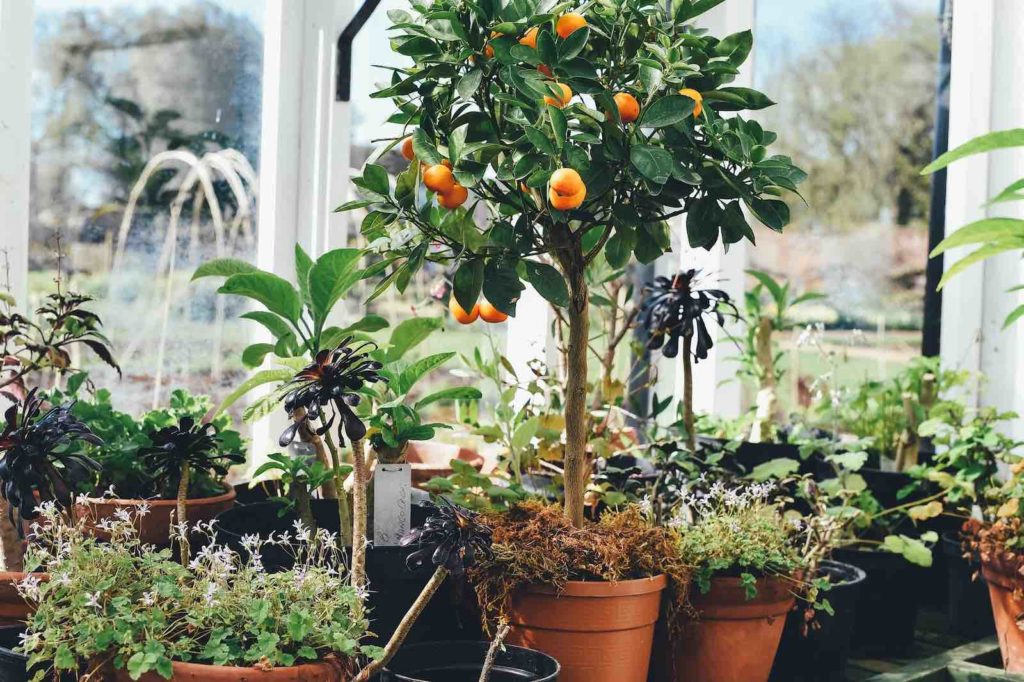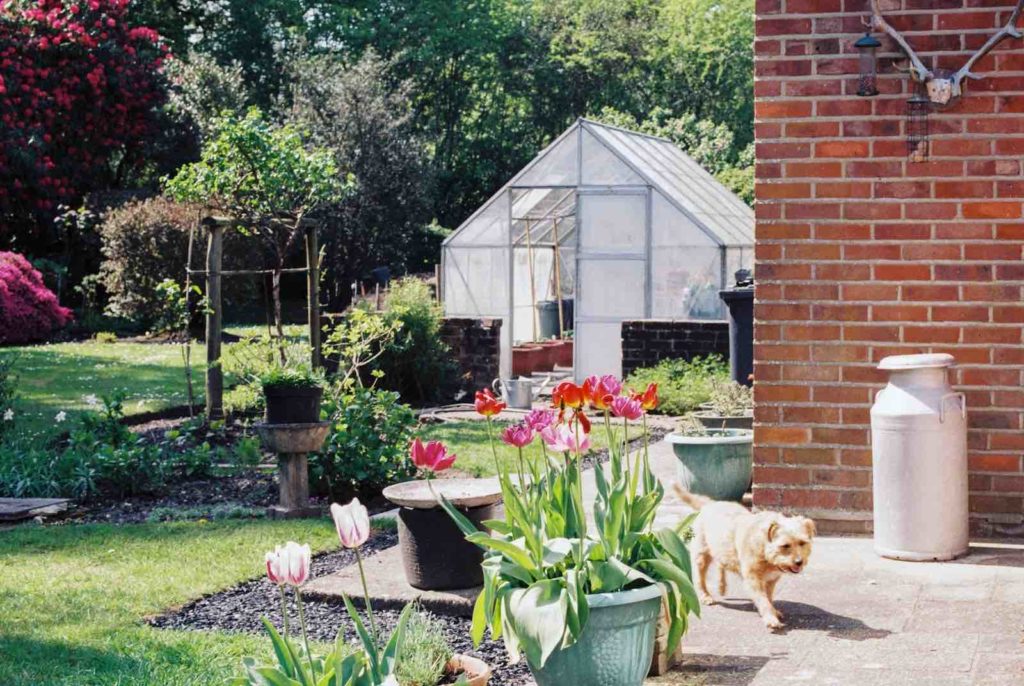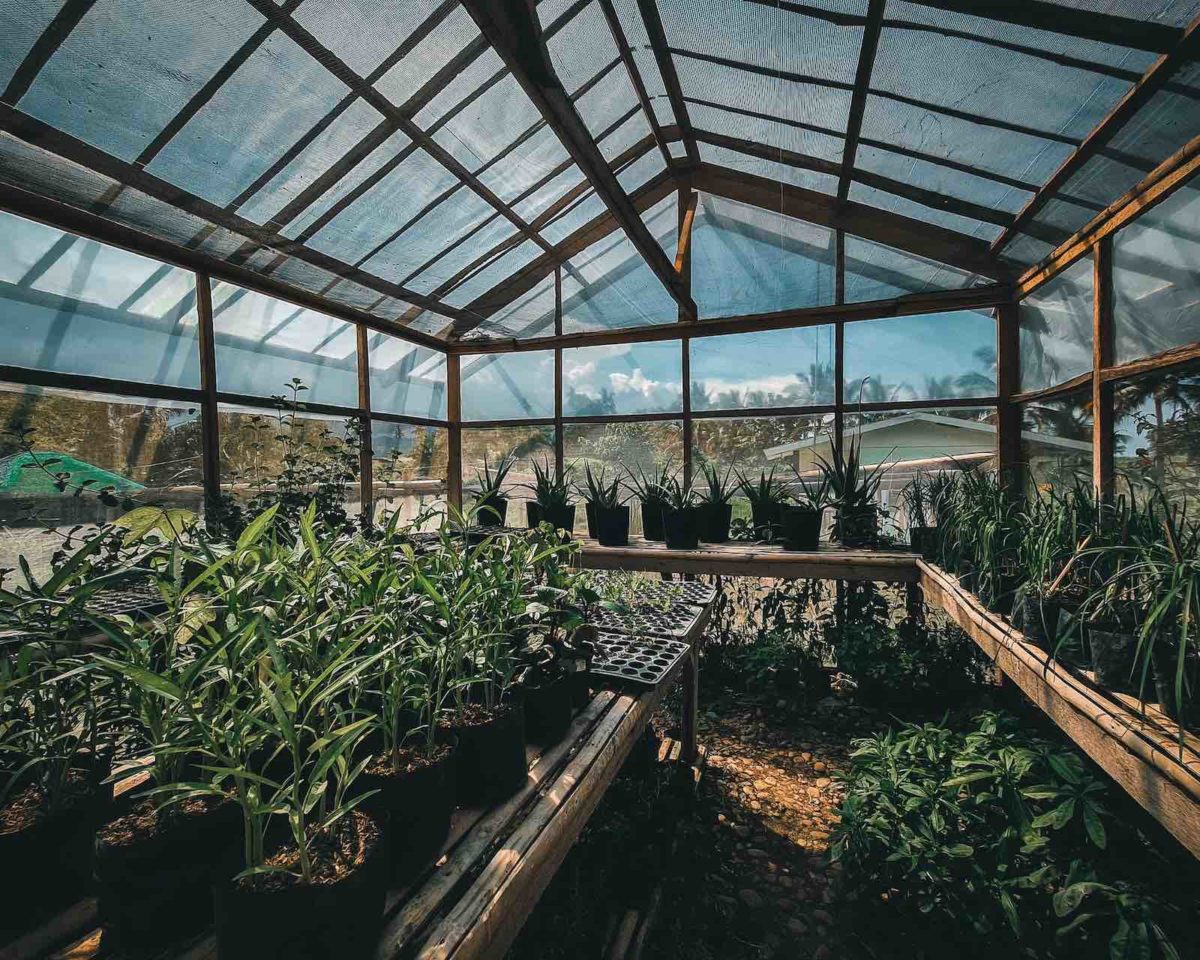Are you ready to get started with your own greenhouse? Fantastic! In this article we’ll give you a complete rundown of how to set up your greenhouse, what to plant in there and how to make sure you get your first starter-greenhouse-harvest, yummy!
The first thing you need to do is draw out a plan of what you want your greenhouse to look like and choose the best possible location for it on your property.
This is important because if the site isn’t suitable for your house or if it has poor drainage, you could be setting yourself up for some major issues.
Once you’ve found the perfect location, measure out how large you want to build your greenhouse for your garden so that your plans are accurate.
What Is the Purpose of a Greenhouse?
Gardeners, home or professionals, use greenhouses to grow plants in controlled conditions, rather than growing plants outside where they are exposed to the elements.
Greenhouse windows let in about 90% of the light that can get into a solid wall structure, letting you control how much sun and heat your plants get.
There are a few common ways gardeners use their greenhouses, but primarily it is used to create a more hospitable environment for plants than the outside world.
Some common ways people use their greenhouse are:
- To grow plants during winter and year-round when they cannot thrive outdoors because of weather conditions; if you’re a gardener that live in a country with non-ideal conditions for growing plants, this is the perfect use for your greenhouse. You can even keep the temperature by using a gas heater or special greenhouse heaters.
- To create a more ideal growing environment for plants, such as a tropical environment; let’s say you live in Sweden and you want to grow bananas, probably not the best way to get the right sun exposure or temperature, right? That’s where the greenhouse comes in.
- You can use your greenhouse to experiment and explore new ways of gardening. Warm up the soil, try growing bananas upside down on shelves, or discover how you can fit more plants into your greenhouse than you could outdoors.
Should I build or buy, this is my first Greenhouse!
There are a lot of things to take into consideration before you start building your greenhouse. For example, if you’re new to gardening and greenhouse growing it might seem easier and wiser to buy one instead of DIY-ing it.
The benefits of DIY-ing a greenhouse include:
- You can make it as big or as small as you want
- It’s cheaper to build your own greenhouse
- You can customize it so that it works perfectly for your garden
- You’ll have the satisfaction of knowing you built it yourself
On the other hand, if you’re not very handy with DIY projects, don’t have a ton of time on your hands or are just plain impatient or want a decent-sized greenhouse that will fit your garden, then it might be better to just buy one.
The benefits of buying a greenhouse include:
- They’re usually very cheap and often come with everything you’ll need to get started
- You have a lot more variety when it comes to the style and size of your greenhouse
- If you’re running a greenhouse business, it makes more sense to buy one because you’ll be using it constantly
- Sometimes buying a greenhouse is much easier because you don’t have to worry about the structural integrity of your greenhouse or where to source all the materials from
Now that you’ve decided whether to build or buy, below you’ll find and overview of the three generic types of greenhouses that exists.
If I build, what’s the ideal location?
If you go down the road of building your own greenhouse, there are a few things you need know about the location you put it in. It should be:
A well-drained location; don’t build it on a slope where water could gather and cause your greenhouse to be flooded. Plus, constant exposure to standing water can cause algae and moss to grow which can harm or kill your plants.
Also, avoid putting the greenhouse near trees so that their roots don’t suck up all the water from the soil.
A sunny location; a greenhouse is a sun trap, so it usually needs as much direct sunlight as possible to grow plants effectively and efficiently.
It doesn’t have to be completely exposed to the sun at all times, but if your greenhouse is in a shady spot you will need to install artificial lighting.
The key is that it needs to have access to natural light.
An easy-access location; you want your greenhouse to be as accessible as possible so that you can go in and out of it easily, work on it from all sides, bring new potting soil and manure without too much strain.
If the path to your greenhouse is difficult to navigate or if your greenhouse sits below/on top of a slope, it won’t be as practical or easy to access.

The 3 types of Greenhouses
There are a variety of styles of hobby greenhouses, however the three most popular for home gardeners are:
Attached
An attached greenhouse is normally built up against a wall of a house. The roof may be only one or two panes high reaching to the eaves of the house.
It can also be built up against an outbuilding such as a shed. The roof style of an attached greenhouse is usually angled to let the maximum amount of light in, but can also be flat.
Cold Frame
A cold frame greenhouse is usually just a glass box with an opening at the top. It’s small and round, not very tall and normally used to protect sensitive plants from the elements.
Freestanding
A freestanding greenhouse is a single structure that has four or more walls and a roof. It can be built on a patio or even outside in your backyard.
It’s normally larger than a cold-frame greenhouse and designed more to grow plants, so it’s taller and has a wider span of glass to let more light in.
Climate control and heating system
If you buy a greenhouse, the heating system and climate control will be done for you. But if you build a greenhouse yourself, it’s up to you to set it up so that your plants have the optimal environment inside the greenhouse.
This requires some research on your part or alternatively, paying someone else to do it.
Here are some things worth considering:
You’ll need a heating system. You can either choose to heat your greenhouse with a combination of heating mats, electric or propane/natural gas space heaters and a thermostat to ensure a precise temperature all times.
Heated benches. People who keep tropical plants or plants that require a lot of warmth usually build heated benches inside their greenhouses, especially in the winter.
These work similar to heating your house with a fire place, but are more energy efficient because they are fuelled by electricity or propane gas.
Greenhouse air circulation & ventilation
Making sure the air inside your greenhouse is up to par is equally important as to making sure you have appropriate temperature control. Greenhouse ventilation is essential primarily for controlling the humidity (and temperature).
You’ll normally require a good ventilation system. If it’s too hot you want to release some of the heat, if it’s too humid you’ll want to open the vents to let some of the moisture out. Many greenhouses have roof vents that you can open manually.
During hot summer days, you may need to install an electric fan in your greenhouse so that the air circulates well between plants and so that there is constant flow of fresh air throughout.
Lights
As briefly mentioned when we spoke about the location and access to sunlight, making sure the plats in your greenhouse are accessing natural light is important. And when it comes to greenhouse lighting, lights are the key. They’re important in two ways:
Plants need lights for photosynthesis. If they don’t get enough light, they’ll grow slowly or wither away.
You have to be able to see what you are doing when working on your plants in the greenhouse so that you avoid the risk of hurting yourself.
Greenhouses generally need a lot of light and should be well lit, but you can set up some sort of lighting if required. There are a variety of lights: artificial lights such as fluorescent tubes, T5 lamps or LED grow lights to name just a few.
You may also find that you don’t need lighting at all if your greenhouse is not far from a window or has an easily accessible source of natural light. In that case, you can just use the windows and let in plenty of light.
What to plant in a Greenhouse?
If you have a greenhouse at your disposal, you want to use it! Apart from the obvious plants that need warm temperatures for their optimal growth (like cacti), there are quite a number of plants you can grow in a greenhouse.
Vegetables like tomatoes and some varieties of beans, carrots and beets will do well in a greenhouse. These plants need warm temperatures but not necessarily constant heat throughout the day. So while it’s important that you don’t expose them to freezing conditions, they also won’t need any sort of heating system since they can tolerate temperature fluctuations just fine (within reason).
The most common things to grow in a greenhouse besides what’s mentioned above is probably cabbage, garlic, lettuce, onions, peppers, potatoes, strawberries, and sunflowers.
Make sure your plants inside get plenty of sun! Isn’t it wonderful to be able to pick your own food from your greenhouse? Yay!

How do I prepare for my first growing season?
Now, what do you say we make this a reality and get to planting some seeds today? First of all, you should water your greenhouse. The soil within should be moist (but not too wet) before you sow your seeds.
Planting in warm weather versus cold weather
If it’s relatively warm outside, you can plant your seeds directly in the soil. However, if the weather is too cold to germinate your seeds, you’ll have to sprout them indoors first.
You may want to invest in some multi-purpose heat mats that are suitable for helping your seeds sprout and grow before planting them outdoors. Or you may want to start them in old milk cartons, which are easy to rip open and plant.
It’s strongly advisable not to sow your seeds too early indoors. The risk of the seedlings withering away is high if they aren’t able to adjust well enough when planted outdoors. Cold soil, cold wind, it’s really harsh on your seedlings.
Recommended reading:
Starter seeds
You may want to purchase starter seeds if you are new to gardening. Germination rates are highest with starter seeds, and it saves you the trouble of having to try out all sorts of different methods for starting your seedlings off.
Some good choices to start with are; tomato, basil, and marigold.
How many seeds should I plant?
If you’re experimenting with starter seeds, it’s best to start with about 3-5 per pot. If you’d rather try different varieties of one plant (such as tomatoes) then sow 5-6 seeds in each pot and thin them out when the seedlings have sprouted. You can do this by cutting off all but a couple healthy seedlings with a pair of scissors.
Fertilizers
It’s advisable to choose a fertilizer that is rich in potash, phosphorus and nitrogen. You need these three ingredients to ensure strong root growth, which you certainly want for your seedlings. Remember to feed your plants about six weeks after sprouting them.
As they grow up it’s best to alternate between feeding the plant lightly once per week with a liquid fertilizer and giving it a good feeding once every two weeks with dry pellets.
Watering
Similar to outdoors, it’s a good idea to water your greenhouse daily. If you don’t have a watering system set up yet, you can use a spray bottle to keep your seedlings moist. You may also want to invest in a drip irrigation system so you don’t have to worry about manually keeping the soil wet every day.
Securing Your Greenhouse
It’s very important that you install a hoop and line system to secure your greenhouse. If the structure isn’t secured it may end up flying away like a kite in high winds!
You should look into getting some sturdy C-shaped hooks as well as clips to attach the line to; if you use U-hooks they’ll tend to come loose because the angle is too sharp.
What tools and equipment do I need?
You’ll also need a soil thermometer to ensure the temperature of your greenhouse doesn’t fall below 60 degrees Fahrenheit. This can happen if you make a mistake in your hoop and line installation, or if the timer on your heating system fails for some reason.
It’s also advisable to get yourself some leaf shears to clip off any branches that are too long. Flower beds can be useful for growing vegetables, herbs and flowers.
It’s important that you use organic methods to begin with, as it may take up to three years for the soil in your greenhouse to become completely free of chemicals.
A potting bench is also very useful for your organic greenhouse. A bench offers great storage space, is easily cleaned in the event of soil spills and doesn’t get moldy like the shelves you may use.
It’s also advisable to invest in some gloves, knee pads and long sleeved shirts before you start hoeing away at the dirt!
If you live on a farm, please also refer to our post about the top 10 power tools you need on your farm!
Happy gardening friends!
FAQ on Greenhouse gardening
A greenhouse is a great way to start your own vegetable garden, and there are several things that you should do when planning out your greenhouse in order to make it a success. For starters, plan where you’re going to locate the greenhouse in your backyard. Make sure it gets plenty of sunlight throughout the day!
After you have decided where to place your greenhouse you should think about installing a hoop and line system to secure the structure. This is especially important if you live in an area that experiences heavy winds. Once it’s set up, begin filling your greenhouse with dirt or potting soil so that it has something to support your plants!
The next step is to get a good soil thermometer to ensure that the temperature in your greenhouse doesn’t drop below 60 degrees Fahrenheit. You should also invest in a drip irrigation system, some organic fertilizer and several other tools and accessories if you plan on starting an organic greenhouse.
Once you’re ready to start planting you’ll want to think about getting a potting bench. A greenhouse bench helps keep your plants neat and orderly, and it is easy to clean in the event of soil spills!
You should place your greenhouse where it gets plenty of sunlight throughout the day. If you live in an area that gets cold weather during winter you should try to place your greenhouse away from the direction of the wind.
